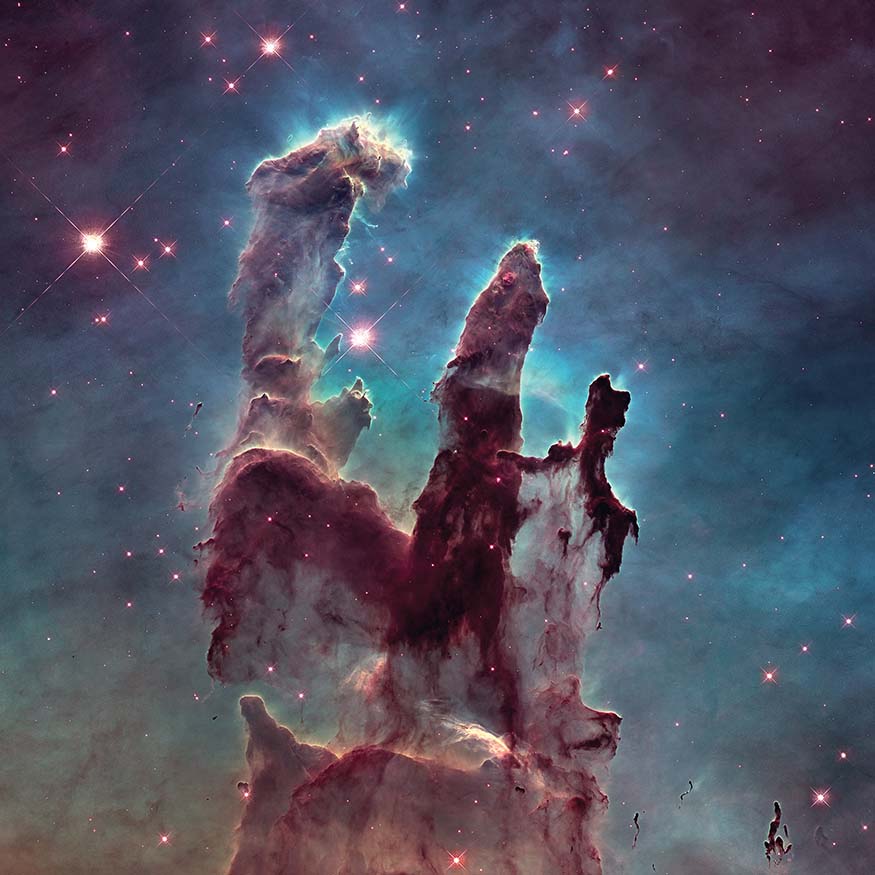
BEAUTY: 
BRAGGING RIGHTS: You saw the “Pillars of Creation”
HOW EASY IS IT TO SEE? Best with a telescope
BEST TIME TO SEE IT: Summer (in Serpens)
TYPE: Diffuse Nebula
DISCOVERED: 1746 by Phillipe Loys de Chéseaux
The frontiers of science often seem far away from us amateurs. None of us is likely to find a cure for cancer in our kitchen or detect the Higgs boson in our garage. And it’s unlikely we can afford to launch a space telescope into orbit, even if we save up all our allowance money for the summer.
Yet professional astronomers study the same sky that you can see from your backyard, so whether you’re receiving data from the Hubble Space Telescope or looking up with binoculars, the same objects are up there, sending their meager rain of photons to anyone willing to grab them.
Sometimes when I see a magnificent image from Hubble, I remember that I, too, have seen the same object. Ironically, my own faint and hazy view makes the Hubble image come alive. It’s like seeing New York City in a movie and remembering the time you visited. Your own memory makes it a real place.
You’ve probably seen Hubble’s famous photo showing columns of glowing gas looming like ghostly stalagmites. They’ve been dubbed the “Pillars of Creation” because they are creating new stars, but before Hubble they were just part of a faint little nebula in the Serpens constellation, called the Eagle Nebula.
It won’t be easy to see this nebula, much less the famous pillars. But whatever you see, I hope you feel a connection to this object that you can’t get from the Hubble photo alone. And I hope you feel a connection, however far away, to the frontiers of science.
WHAT YOU MIGHT SEE THROUGH AMATEUR EQUIPMENT
This is the faintest object in the Top 20. Binoculars reveal the associated cluster of stars, but not the nebula. Even a small telescope is insufficient to see much more than a faint haze.
Wait for a dark and moonless night and use at least an 8-inch telescope—preferably a short-focal length Newtonian.
You can find the Eagle Nebula in the summer. Look for the teapot in Sagittarius and scan the area above it. Above and to the left of the Lagoon Nebula you’ll see a ghostly checkmark. That’s Messier 17 or the Swan Nebula. Not far above that will be the Eagle Nebula.
At first you’ll only see a cluster of stars, but patience (and sufficient aperture) will reveal the nebula.
Don’t pass up the chance to see the Eagle Nebula through a large (14-inch-plus) telescope. Star parties or local observatories are a great way to see this elusive, but beautiful, nebula.
The nebula. The nebula itself is visible in an 8-inch or larger telescope. The cluster of stars is surrounded by nebulosity: this is the head of the eagle. The “wings” of the eagle are faint patches of nebula spreading out.
Try using a nebula filter, which increases the contrast of the glowing gases. If light pollution is washing out your view, the filter might help.
Pillars. Between the two wings you might be able to see a dark patch of darkness. Scan this area with averted vision. With patience, luck, and maybe a little imagination, you might see one or two pillars of darkness.
Astrophotography. Even modest equipment captures the ghostly pillars. You’ll need a telescope with a tracking mount and either a dedicated astronomical camera, or a DSLR with an appropriate adapter. Aim to expose for at least a minute without visible star trails.
Long-exposure astrophotography takes lots of patience and practice. It is not a task for beginners. But once you’ve perfected your technique on the Orion Nebula, aim your camera at this target and see if you can capture the “Pillars of Creation” for yourself.
SAGITTARIUS REGION IN SUMMER; 30-DEGREE FIELD OF VIEW